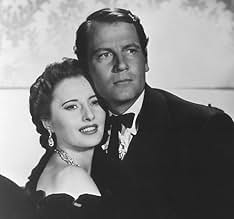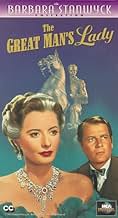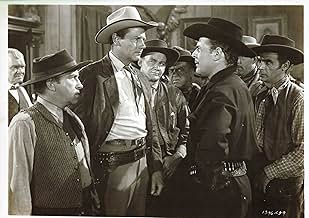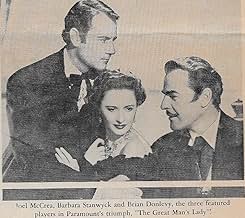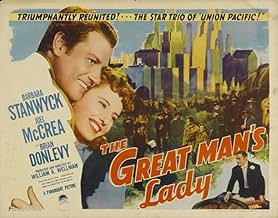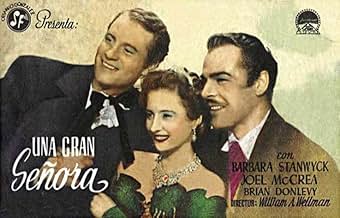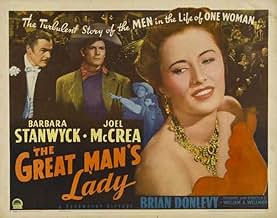A 100-year-old pioneer woman tells her story in flashbacks.A 100-year-old pioneer woman tells her story in flashbacks.A 100-year-old pioneer woman tells her story in flashbacks.
- Awards
- 2 wins total
K.T. Stevens
- Girl Biographer
- (as Katharine Stevens)
Irving Bacon
- Parson
- (uncredited)
Hank Bell
- Man #1 - Hoyt City
- (uncredited)
Monte Blue
- Man #2 - Hoyt City
- (uncredited)
Featured reviews
Unfortunately, whatever production values this film contains are generally spoiled by the passage of time and fortunate changes in perspective. For those of us watching now are happily forewarned in the narrator's introduction to the film in which it is not only explicit as to the woman character's subordinate position to her "great man" but also at least implicit as to the role of any woman in the life of her "great man." Of the many "flash-back" films where the character re-hashes their past, this is certainly melodramatic in its acting and characterizations. The action does not seem compelling to watch, as if one could fast-forward to get to the punch line, which does not really satisfy - the principal male character's life is summed up in such high regard as to make one wonder if the viewer had just seen the same film! One has to wonder how female audience members felt about the general message (such as it is) of this film when it opened in theatres, although Ms. Stanwyck most likely held her own in her stubbornness by standards of the time.
Saddled with an uninspiring title, "The Great Man's Lady" is less than the sum of its parts. Hoyt City unveils an equine statue of its founder, Ethan Hoyt, which unleashes a bevy of news reporters intent on delving into his life and the mystery of why he returned to die in the home of a local woman, Hannah Semple. While most of the reporters are dismissed, a young biographer manages to win the trust of the elderly Hannah, who proceeds to tell her about Ethan Hoyt in a series of flashbacks. However, Hannah's tale is a routine story of ambition, risk, and tragedy that led to wealth and high political office; a successful man and the woman who aided his rise. Unfortunately, a near-century in the life of a remarkable woman is impossible to squeeze into a 90-minute running time, and decades are omitted between flashbacks; the episodic film has several unseen characters and unexplained events.
Aided by aging make-up that is remarkably convincing for the period, Barbara Stanwyck plays Hannah Semple from a flirtatious 16-year old to the 109-year-old woman who recalls her life for the biographer. Her tour-de-force performance is the film's prime asset, and Stanwyck has some fine, if occasionally sudsy, moments. In the fifth of their six co-starring features, Joel McCrea as the great man, Ethan Hoyt, plays well opposite Stanwyck, although his role is far less demanding than hers and rests on his considerable charm. Beyond Hoyt's rise to prominence, a romantic triangle is also central to the story, and Brian Donlevy, who often played the villain, is gambler Steely Edwards; Donlevy's part, a heavy with a heart, does demonstrate genuine affection for Hannah and respect for Hoyt.
Nearly equal in importance to Stanwyck and McCrea, the third star of the film is cinematographer William C. Mellor, whose shadowy black and white photography is often stunning. Capturing the actors in silhouettes or darkly garbed against light backgrounds, several shots could be framed and hung in a gallery. Mellor also photographs the leads and even extras in sharply delineated close-ups that rival the best studio portraits. The talented cameraman subsequently earned Academy Awards for "A Place in the Sun" and "The Diary of Anne Frank," among other nominations and accolades in his long distinguished career.
Well directed by veteran William Wellman, "The Great Man's Lady" is a predictable story of an important self-made man, who owes much of his success to the woman behind him. However, without Stanwyck's captivating performance, McCrea's charisma, and Mellor's rich cinematography, the film would barely merit attention.
Aided by aging make-up that is remarkably convincing for the period, Barbara Stanwyck plays Hannah Semple from a flirtatious 16-year old to the 109-year-old woman who recalls her life for the biographer. Her tour-de-force performance is the film's prime asset, and Stanwyck has some fine, if occasionally sudsy, moments. In the fifth of their six co-starring features, Joel McCrea as the great man, Ethan Hoyt, plays well opposite Stanwyck, although his role is far less demanding than hers and rests on his considerable charm. Beyond Hoyt's rise to prominence, a romantic triangle is also central to the story, and Brian Donlevy, who often played the villain, is gambler Steely Edwards; Donlevy's part, a heavy with a heart, does demonstrate genuine affection for Hannah and respect for Hoyt.
Nearly equal in importance to Stanwyck and McCrea, the third star of the film is cinematographer William C. Mellor, whose shadowy black and white photography is often stunning. Capturing the actors in silhouettes or darkly garbed against light backgrounds, several shots could be framed and hung in a gallery. Mellor also photographs the leads and even extras in sharply delineated close-ups that rival the best studio portraits. The talented cameraman subsequently earned Academy Awards for "A Place in the Sun" and "The Diary of Anne Frank," among other nominations and accolades in his long distinguished career.
Well directed by veteran William Wellman, "The Great Man's Lady" is a predictable story of an important self-made man, who owes much of his success to the woman behind him. However, without Stanwyck's captivating performance, McCrea's charisma, and Mellor's rich cinematography, the film would barely merit attention.
From the first intro scroll itself, the film shows how dated it is and how stupid it can be with the themes in it. The first half hour went along proving it to me with every character and plot point just fast-forwarding itself to seemingly pointless places. But the rest of the movie, even though doesn't really get out of those aspects gives Barbara Stanwyck a great chance to show her acting prowess and she single-handedly saves the film.
The film can be considered an optimistic look at the tragedy that is any human life. But the privilege of the characters, the lack of feeling any stake even when it is needed and the lacklustre narrative doesn't really help in its philosophy. A lot of the movie, especially the scroll at the beginning and the ending sequence feels like the makers believed it to be something epic when it isn't even remotely close to being that.
Even with all of that and some of the regressive messages, the film believes to be progressive, the film still contains enough to appreciate it for what it is. The movie does portray moments that are representative of how small and yet great life is and Barbara Stanwyck makes it work with her charm and presence. I feel like this same exact story could've been a great film with a better script. I don't know how common this type of story was back then but maybe this film has inspired many other filmmakers afterwards.
The film can be considered an optimistic look at the tragedy that is any human life. But the privilege of the characters, the lack of feeling any stake even when it is needed and the lacklustre narrative doesn't really help in its philosophy. A lot of the movie, especially the scroll at the beginning and the ending sequence feels like the makers believed it to be something epic when it isn't even remotely close to being that.
Even with all of that and some of the regressive messages, the film believes to be progressive, the film still contains enough to appreciate it for what it is. The movie does portray moments that are representative of how small and yet great life is and Barbara Stanwyck makes it work with her charm and presence. I feel like this same exact story could've been a great film with a better script. I don't know how common this type of story was back then but maybe this film has inspired many other filmmakers afterwards.
With the dedication of a statue in honor of the late great Ethan Hoyt(Joel McCrea) happening in the city which bears his name, reporters from all over rush to the home of Hannah Sempler(Barbara Stanwyck), rumored to have once been married to him, to get her opinion and answers to all of their questions. But without giving any meaningful responses, she chases them away. However, one young woman(Katharine Stevens) remains, desperately wanting to write a biography about Hoyt. Hannah brusquely tells her to come back in a hundred years when they are both old women but reconsiders, taking pity on her to start her story when she was a young woman in Philadelphia in 1848 when she runs away with Hoyt to avoid being married to Mr. Cadwallader(Lloyd Corrigan). Aided by excellent performances, especially Brian Donlevy in support, "The Great Man's Lady" is a very entertaining and touching tribute to those pioneers who thought big in building this country from the ground up and sacrificed much along the way. While smartly advocating for privacy and the public need not know every detail, the movie takes the Great Man Theory down a notch by commenting blithely that they could not have done it alone, as dreamers always need a partner to ground them to reality in order for them to fully succeed.(It does not hurt if she can handle a hunting rifle, like Hannah can.) And it is not just feminism that puts this movie far ahead of its time, as it is filmed innovatively with a stunning opening sequence that begins with a shot of the house before panning wider to reveal the city that has risen up around it. Sound familiar?
Joel McCrea and Barbara Stanwyck made six films together, the most they did respectively with other leads. The Great Man's Lady while not the best example of their joint work is certainly one interesting if somewhat incredible film.
I can certainly see what attracted Stanwyck to a role that was part Maytime and part any number of Edna Ferber like tales of empire builders. Stanwyck is certainly a better actress than Jeanette MacDonald and she really does carry off the part of the 107 year old pioneer woman who is telling a young reporter about her most interesting life.
Like in Cimarron, McCrea and Stanwyck start out for the west in the 1840s in search of opportunity and like in Cimarron the woman is being taken from a life of ease and comfort to become a pioneer. The film shows how very useful she was to him.
Albeit even with her conservative politics in real life, Stanwyck was a feminist icon and in the 19th century without even the right to vote, women held a far different position than they do legally now. What help she renders to McCrea is on the unofficial side. But as the story unfolds she contributes mightily to his rise to fame and power and sacrifices EVERYTHING for him.
I'd like to give the film a higher rating, but the thing that totally throws me is the part her father plays in her ultimate decision. Thurston Hall is Stanwyck's father and he's a typical robber baron of the era. But I can't see any father asking his daughter to do what she did for business reasons. It makes the whole story quite bizarre.
McCrea and Stanwyck liked each other personally and professionally. In Tony Thomas's book about Joel McCrea based on interviews he did with him in the Eighties, McCrea said that Barbara Stanwyck was his favorite leading lady. She was thoroughly professional and helpful to every other cast member in any film she was in. He had no qualms in saying that The Great Man's Lady is her film all the way.
It's far from her best film, but for Barbara Stanwyck fans it's one of her best performances.
I can certainly see what attracted Stanwyck to a role that was part Maytime and part any number of Edna Ferber like tales of empire builders. Stanwyck is certainly a better actress than Jeanette MacDonald and she really does carry off the part of the 107 year old pioneer woman who is telling a young reporter about her most interesting life.
Like in Cimarron, McCrea and Stanwyck start out for the west in the 1840s in search of opportunity and like in Cimarron the woman is being taken from a life of ease and comfort to become a pioneer. The film shows how very useful she was to him.
Albeit even with her conservative politics in real life, Stanwyck was a feminist icon and in the 19th century without even the right to vote, women held a far different position than they do legally now. What help she renders to McCrea is on the unofficial side. But as the story unfolds she contributes mightily to his rise to fame and power and sacrifices EVERYTHING for him.
I'd like to give the film a higher rating, but the thing that totally throws me is the part her father plays in her ultimate decision. Thurston Hall is Stanwyck's father and he's a typical robber baron of the era. But I can't see any father asking his daughter to do what she did for business reasons. It makes the whole story quite bizarre.
McCrea and Stanwyck liked each other personally and professionally. In Tony Thomas's book about Joel McCrea based on interviews he did with him in the Eighties, McCrea said that Barbara Stanwyck was his favorite leading lady. She was thoroughly professional and helpful to every other cast member in any film she was in. He had no qualms in saying that The Great Man's Lady is her film all the way.
It's far from her best film, but for Barbara Stanwyck fans it's one of her best performances.
Did you know
- TriviaOne of over 700 Paramount productions, filmed between 1929-49, that were sold to MCA/Universal in 1958 for television distribution, and have been owned and controlled by Universal ever since. Its initial television broadcasts took place in Los Angeles Thursday 8 January 1959 on KNXT (Channel 2) and in St. Louis Friday 9 January 1959 on KMOX (Channel 4). In Seattle, it first aired 24 July 1959 on KIRO (Channel 7), in Phoenix 8 August 1959 on KVAR (Channel 12), in Milwaukee 27 September 1959 on WITI (Channel 6), in Pittsburgh 26 October on KDKA (Channel 2), in Detroit 29 October 1959 on WJBK (Channel 2), in Toledo 19 December 1959 on WTOL (Channel 11), in Omaha 22 December 1959 on KETV (Channel 7), in Grand Rapids 27 December 1959 on WOOD (Channel 8), in Chicago 29 December 1959 on WBBM (Channel 2), in New York City 26 March 1960 on WCBS (Channel 2), in Minneapolis 9 November 1960 on WTCN (Channel 11), in Philadelphia 22 December 1962 on WCAU (Channel 10), and in San Francisco 3 February 1963 on KPIX (Channel 5). It was released on DVD 27 April 2010 as one of six titles in Universal's Barbara Stanwyck Collection and on 13 July 2015 as a single as part of the Universal Vault Series; since that time, it's also enjoyed occasional airings on Turner Classic Movies.
- GoofsWhen the Hoyts stand at the sight of their future city, they're at the foot of a hill, but moments later they're on top of a hill.
- ConnectionsFeatured in Biography: Barbara Stanwyck: Straight Down the Line (1997)
- SoundtracksUnfinished Symphony
("Symphony 8 in B Major") (uncredited)
Composed by Franz Schubert (begun 1822)
Heard on soundtrack during Janet and Ethan's farewell and under end title
- How long is The Great Man's Lady?Powered by Alexa
Details
- Runtime1 hour 30 minutes
- Color
- Aspect ratio
- 1.37 : 1
Contribute to this page
Suggest an edit or add missing content


